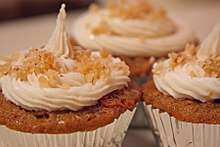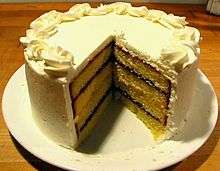Carrot cake
Carrot cake is cake that contains carrots mixed into the batter. Most modern carrot cake recipes have a white cream cheese frosting. Sometimes pecans, pineapple, and shredded coconut is added in the mix.
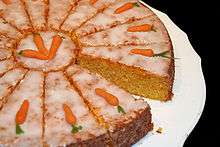 | |
| Type | Loaf, sheet cake, layer cake |
|---|---|
| Place of origin | Disputed; either England, France, or Switzerland |
| Main ingredients | Flour, eggs, sugar, carrots, almonds and baking powder[1] |
| Variations | Hazelnuts, lemon, kirsch, cinnamon[1] |
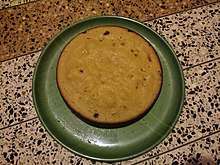
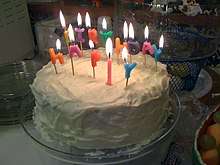
History
The origins of carrot cake are disputed. Published in 1591, there is an English recipe for "pudding in a Carret(sic) root"[2] that is essentially a stuffed carrot with meat, but it includes many elements common to the modern dessert: shortening, cream, eggs, raisins, sweetener (dates and sugar), spices (clove and mace), scraped carrot, and breadcrumbs (in place of flour). Many food historians believe carrot cake originated from such carrot puddings eaten by Europeans in the Middle Ages, when sugar and sweeteners were expensive and many people used carrots as a substitute for sugar.[3] Variations of the carrot pudding evolved to include baking with a crust (as pumpkin pie), steamed with a sauce, or molded in pans (as plum pudding) with icing.[3]
In volume two of L'art du cuisinier (1814), Antoine Beauvilliers, former chef to Louis XVI,[4] included a recipe for a "Gâteau de Carottes",[5] which was popular enough to be copied verbatim in competitors' cookbooks.[6][7] In 1824, Beauvilliers had published in London an English version of his cookbook which includes a recipe for "Carrot Cakes" in a literal translation of his earlier recipe.[8][9]
Another 19th-century recipe comes from the housekeeping school of Kaiseraugst (Canton of Aargau, Switzerland).[10] According to the Culinary Heritage of Switzerland, it is one of the most popular cakes in Switzerland, especially for the birthdays of children.[10]
The popularity of carrot cake was revived in the United Kingdom because of rationing during the Second World War.[11]
See also
Notes and references
- (in German) Aargauer Rübelitorte, www.kulinarischeserbe.ch (page visited on 31 July 2014).
- A. W. (1591). A Book of Cookrye: Very Necessary for All Such as Delight Therin. Edward Allde.
- "The History of Carrot Cake". www.carrotmuseum.co.uk. Retrieved 15 January 2018.
- Furlaud, Alice (12 July 1989). "What Do You Do Apres la Revolution? Go Out to Eat" – via NYTimes.com.
- Beauvilliers, Antoine Auteur du texte (31 July 1814). "L'art du cuisinier. T. 2 / par A. Beauvilliers,..." pp. 127–128 – via gallica.bnf.fr.
- A. Viard; Fouret (1820). Le cuisinier royal: ou l'Art de faire la cuisine, la patisserie et tout ce qui concerne l'office, pour toutes les fortunes. J.-N. Barba. pp. 405–.
- Colburn's New Monthly Magazine. 1842. p. 12.
- "The art of French cookery". London : Printed for Longman, Hurst, Rees, Orme, Brown, and Green. 31 July 1824 – via Internet Archive.
- Antoine B. Beauvilliers, The Art of French Cookery … , 3rd ed. (London, England: Longman, 1827), page 227.
- (in French) Véronique Zbinden "Patrimoine culiraire suisse (9/14). Rueblitorte, gâteau végétal et fédéral", Le Temps, Thursday 31 July 2014, page 10.
- Olver, Lynne. "Cake History Notes". The Food Timeline. Retrieved 1 January 2012.
Bibliography
- Alton Brown, I'm Just Here for More Food: Food × Mixing + Heat = Baking, New York: Stewart, Tabori & Chang, 2002 (ISBN 1-58479-341-4).
- Alan Davidson, Oxford Companion to Food, second edition, illustrations by Soun Vannithone, London: Oxford University Press, 2006 (ISBN 0-19-280681-5).
